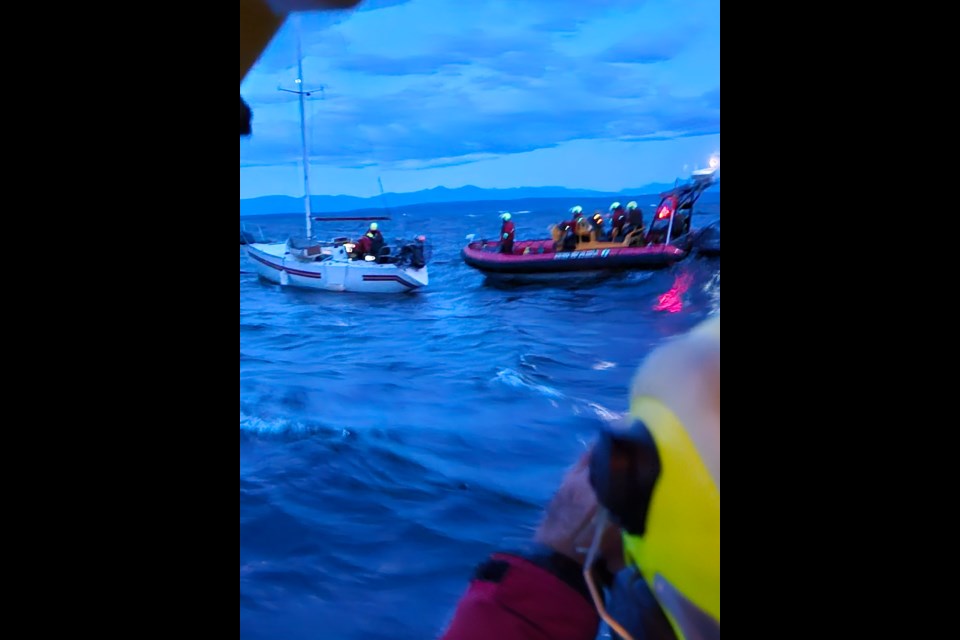A mayday call at nearly 4 a.m. last Thursday morning saw Gibsons volunteers jumping into action to rescue a “not seaworthy” vessel that had attempted to cross the Strait of Georgia in stormy seas.
And was a busy night for the volunteers at the Royal Canadian Marine Search and Rescue (RCMSAR) Station 14, operated out of Gibsons, as they responded to two callouts in short order.
'Somewhere in the Salish Sea'
A few hours after attending a stalled sailboat in Gibsons Harbour, Station 14 received a mayday call at approximately 3:45 a.m., Thursday, July 25.
RCMSAR volunteer Tess Huntly said they had very little information to go off initially. They were tasked to find a sailboat that was taking on water and at risk of sinking “somewhere in the Salish Sea, south of Roberts Creek.”
The crew of four set out immediately, leaving Gibsons just after 4 a.m.
Huntly described the conditions as, “heavy seas, strong winds and dark,” with three to four-foot waves coming at them.
Once the crew was under way, they got a GPS location from the sailboat operator's cellphone as he had no navigational equipment onboard.
The Gibsons crew was the first on the scene and intercepted the sailboat about three-quarters of the way across the Straight of Georgia, heading in the direction of Thrasher Rock near Gabriola Island.
Huntly said they arrived to find a young man aboard the 35-foot sailboat with a racing hull, which she described as “not seaworthy.”
The team sent one crewmember over to the sailboat, a manoeuvre which Huntly said was very difficult and required careful seamanship due to the high waves and stormy conditions, so they could ascertain the leak situation.
Huntly said the man was understandably quite panicked when they arrived, being in the dark, facing high seas while taking on water. They determined the man had been anchored somewhere off Vancouver Island, near Newcastle Island, and his anchor line had broken.
With no secondary anchor, the operator decided to try to head to Kitsilano – which quickly became a serious situation when he realized the extent of the storm and the fact he was taking on water.
When they arrived, the rescuers determined that there was no leak or that a leak had been sealed and that the boat was taking on water from the waves. Instead of the electric bilge that many boat operators have on board, this boat operator was managing the water using a kayak hand pump.
The mayday call had been sent to all surrounding RCMSAR stations as the location of the sailboat was originally unknown. RCMSAR Station 27 from Nanaimo arrived on the scene, also sending a crew member to the boat and accompanying the man back to Silva Bay Marina on Gabriola Island, the nearest safe harbour.
The Canadian Coast Guard also attended the scene with the Hovercraft Siyay to handle scene management.
Huntly said they see situations similar to this where not very experienced sailors on not strong seagoing vessels find themselves in extremely dangerous situations when the weather is beyond what they can handle.
“Part of it is making sure that you're equipped with basic safety equipment, personal floatation devices, electronic bilge pump, radio, those things that are going to help you in an emergency,” she said.
The team from Station 14 got back to base and debriefed around 6:30 a.m., at which point they enjoyed some much-deserved rest.
Fouled propeller
Before the mayday call, the first callout of the night came at approximately 11 p.m. A sailboat was suffering a fouled propellor just outside of Gibsons Harbour.
Huntly said by the time the three SAR crewmembers reached the sailboat, the operator had managed to anchor it and had been going back and forth from his boat to the dock using a smaller tin boat with a motor.
The boat operator had a dog with them that Huntly said had been transported to Gibsons dock before crews arrived.
“So the dog was greeting us at the boathouse when we went to load up the boat and we were really confused as to where this dog came from and was jumping all around––it turned out to be his dog,” Huntly said.
She said it was clear the operator was experienced and knew what they were doing.
After the operator reassured the crew that he was fine, the boat was taken to their boathouse.
Talking to Coast Reporter on July 26, Huntly said this is an opportunity to recognize not only the volunteers who go out on these calls but also their families who see them going out at all times of day.
“It’s a lot of volunteer hours that we put in as crew members and coxswains and it's a big deal to offer that to the community,” she said,“365 days a year, 24 hours, we're ready to respond.”
Jordan Copp is the Coast Reporter’s civic and Indigenous affairs reporter. This reporting beat is made possible by the Local Journalism Initiative.



